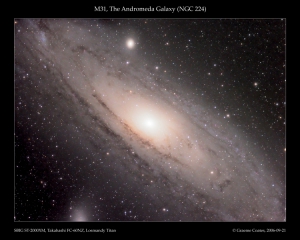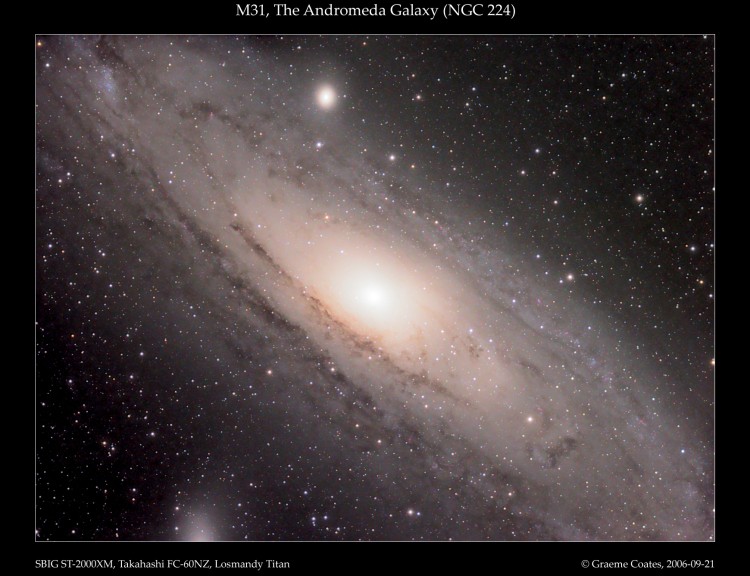RA: 00h 42m 44.3s, Dec: +41°16′ 9″
The Andromeda Galaxy is a naked eye object from a dark site, appearing as a small smudge in the sky. Long exposures reveal it’s true extent (over three degrees in size!) as well as two smaller elliptical companion galaxies (M32 – top, and M110 – bottom edge partially off frame). It is a member of the Local Group of galaxies, and is actually moving towards us at a rate of about 300km/s. Taken from Abingdon, UK on the evening of September 21st, 2006.
This picture was chosen as Anacortes Telescope & Wild Bird picture of the day on 6th Nov 2006.
Additionally, it was chosen as Sky at Night Magazine Hotshots Picture of the Month, Feb 2007 and subsequently it was chosen as Sky at Night Magazine Hotshot of the Year, 2007. (Sky at Night Magazine). As part of the Sky at Night Hotshots competition, I won a 5x Astro Engineering barlow lens for the photo of the month, and a DMK41AF02.AS camera from The Imaging Source.
I’m very happy with this one – if anything, it needs a bit more data – especially in the colour channels – I’m tempted to have another go at this, maybe as a mosaic at a later date 🙂
![]() M31 (NGC 224) – The Andromeda Galaxy by Graeme Coates is licensed under a Creative Commons Attribution-NonCommercial-ShareAlike 4.0 International License.
M31 (NGC 224) – The Andromeda Galaxy by Graeme Coates is licensed under a Creative Commons Attribution-NonCommercial-ShareAlike 4.0 International License.

@Jonathan – Thanks for the link over to the new blog – I’m in the process of migrating my old stuff over into the blog (so a flurry of activity to come), as well as hopefully doing some “new” stuff too – busy!
I understand you took this photo with an ImagingSource camera. I just bought one. This is my first attempt to use a camera of any kind. I am also involved in setting up an Astrophotography SIG with the Prescott, AZ, (USA) astronomy club. It would be a real treat if you would send me a detailed outline of how you took this photo and how you processed it, including the kind of software and other equipment you used.
@ John – The image was taken with an SBIG ST2000XM – but I won an ImagingSource camera as a prize from the Sky at Night Magazine “Hotshots” photo competition with this image.
However, there’s almost certainly no reason why you couldn’t take a good image like this using an ImagingSource camera – you’d need to use long exposures on the camera, and take many subs, and make sure you calibrate them using dark frames. The AS camera should be capable of doing this.
For the image above, I used a 60mm Takahashi at f8.3, with 30x2min frames for the luminance. The colour was 6x3min for each colour, binned 2×2. Processed using CCDSoft, Ray Gralak’s Sigma and Photoshop. The AS cameras may need slightly more exposure (and any extra exposure won’t hurt if your mount can track or guide well enough!) due to the smaller pixel size, and higher thermal and (probably) read noise.
The tricky part in processing is controlling the birghtness of the core – do this by using the “curves” function carefully to pull the galaxy out from the background, and also later on using a mask to prevent the core of the galaxy burning out too much whilst pulling the outer arms up in brightness. A bit of local contrast enhancement afterwards helps to pull out the dust lanes towards the core (using Noel Carboni’s Photoshop plugins).
Hope that helps!